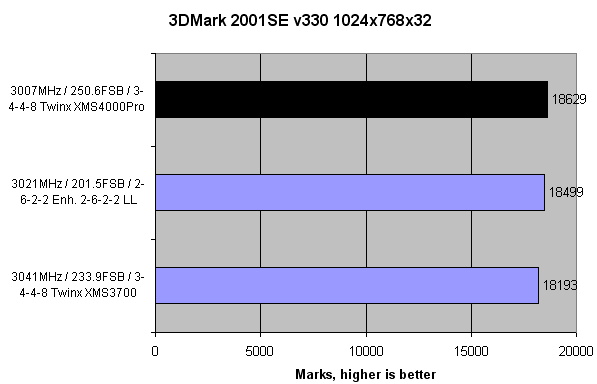Benchmarks and thoughts

A synthetic win for the 1GByte pairing. The 512MByte low latency set does well here, no doubt helped by the new performance BIOS from EPoX.

Unbuffered bandwidth doesn't always translate into superior performances in real-world benchmarks, as we can see here. 250FSB running, giving a potential 8GB/s from the dual-channel memory controller, still can't beat the 6.4GB/s-capable settings. Latencies appear to be more important than pure bandwidth in this instance. It's all well and fine stating that RAM modules will run at PC4xxx speeds, yet manufacturers need to tighten the latencies if tangible performance gains over low latency DDR400 memory is to be had.

Gaming, though, prefers pure bandwidth, or the greater bandwidth overcomes the penalties associated with higher latencies. Only just, though. Let's have a second look at our configurations. A pukka 3.2GHz P4 costs in excess of £500 and a 2.4GHz costs ~ £140. Sure, the 3.2GHz will most likely overclock further than the 2.4GHz model, but we equal or match its stock performance with the use of some extremely high bandwidth RAM.

UT2003 shows a very slightly different story, with low latency RAM coming out on top by the smallest of margins. PC3700 memory isn't all that far behind the leading duo.

Quake III sees the closest battle yet, with high latency / high bandwidth RAM on one side and super low latency RAM on the other. We're sure that if the Corsair was clocked up by another MHz, thereby giving an equal CPU speed, it would extend its very slender lead. The newer EPoX 4PDA2+ motherboard BIOS seems to favour tight timings over pure MHz, evidently.
The Corsair XMS4000
ProSeries TwinX dual channel memory kit adds a novel twist to a proven
formula. Whilst many will see the inclusion of LEDs as a major gimmick
with no real informative value, modders and enthusiasts with an eye for
style, a group that make up a reasonable proportion of ultra-high-speed
RAM module sales, will undoubtedly be pleased to see such an individual set
of memory. The best looks in the world are great, but if the memory
can't seem to do stated speeds, then one is getting what one paid for.
We tried the ProSeries kit in 4 separate Intel-based modules and only
one of
the illustrious quartet could run the Corsair modules, in dual channel form, at the required
3-4-4-8 timings and 2.75v. Other motherboards required a little extra
juice to ensure stability. If extra volts are being pumped through the
modules to satisfy specifications, you can clearly assume that there's very little
headroom left, or there's a serious compatibility problem.
Indeed, DDR510 speeds
were only stable in the IC7. It's
difficult to comment on whether this is an isolated case or widespread
issue. Our previous experiences with Corsair memory lead us to believe
the former, but the nagging feeling that this is basically DDR400 3-3-3
memory overclocked to DDR500 speeds doesn't help matters. At DDR500,
it's pretty darn fast. The problem is in ensuring that you get to this
plateau in the first instance, and in ensuring that your motherboard
will allow you to go that high.
We'd like two things from the next iteration of super-fast RAM. Firstly, high speeds accompanied with lower latencies. Secondly, lower voltages for said speeds. That statement seems to contain a couple of mutually exclusive terms. We hope that DRAM manufacturers can rise to the challenge. This is perhaps the most unusual DRAM we've come across in a while. It's certainly got instant attention-grabbing appeal. We just wish the chips underneath would be partial to a number of Springdale-equipped boards.














